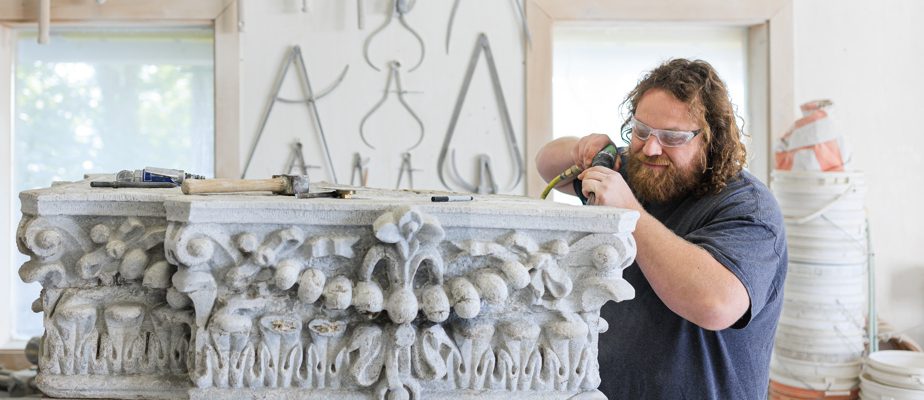Standing for ages or recently erected, many stone buildings help shape the character of our province. A school open to all, brought together by craftsmen, was created to pass on this know-how. Sculpture, ornament, utility object… whatever the nature of the project, they are there to guide you.
Adrien Bobin and Alexandre Maquet have been working as stonemasons for 20 and 25 years. “I have my workshop on the Île d’Orléans, but I have projects everywhere; a lot in Quebec, sometimes in Montreal, and I work mainly, just like Alex, in the heritage field,” informs Adrien Bobin, who did a journey through companionship in France, but is not a companion, he insists. “We therefore restore stones on heritage buildings, but we also have a clientele of individuals for new properties. »

PHOTO EDOUARD PLANTE-FRÉCHETTE, LA PRESS
Adrien Bobin
The two men met around fifteen years ago through gatherings between artisans as members of the Crafts Council. Then, they carried out a first joint professional project in 2015. “We realized that it was really easier and more pleasant to collaborate. There are not a lot of stonecutters in Quebec, and the Crafts Council has developed several training courses that we have had to give,” explains Alexandre Maquet.

PHOTO HUGO-SÉBASTIEN AUBERT, THE PRESS
Alexandre Maquet poses with one of his creations.
They had already toyed with the idea of giving one-day courses to help preserve their know-how. “We met academics passionate about heritage who had the good idea to take us out of our workshops and shed light on the work of artisans, which pushed us to mobilize with the aim of making our knowledge known. professions,” continues Mr. Maquet, adding that at the same time, the Cégep du Vieux Montréal was developing a heritage program. “Giving the course in this area helped us start our project. »
Chance often does things well since one of their friends, the sculptor Michèle Lavoie, sold her school and wanted to get rid of her equipment. It was the trigger to start Les Ateliers de la pierre du Québec, an NPO.
-

PHOTO HUGO-SÉBASTIEN AUBERT, THE PRESS
At Ateliers de la pierre, you can learn to work stone in multiple ways.
-

PHOTO HUGO-SÉBASTIEN AUBERT, THE PRESS
Each person arrives with their project, and professionals are there to guide them.
-

PHOTO HUGO-SÉBASTIEN AUBERT, THE PRESS
Sculpture, ornament, utility object; the stone offers multiple possibilities.
1/3
Catching the virus, one cut stone at a time
Located at 4710 rue Saint-Ambroise in Montreal, the school trains both novices and experienced people. Each student benefits from a fully equipped and secure workstation. “We ask people to come with a project, then we support them by telling them what is possible,” explains Alexandre Maquet, who is one of the three teachers on site. It’s very varied, because all styles are in demand; some like to do realistic things, others prefer the abstract. Many people really get the bug! »
Firstly, beginners learn to use the tools, to know the different types of stone, then work on their work, guided by the craftsmen. Little by little, everyone becomes more independent.
The most qualified mainly expect technical recommendations, because they know what they want artistically, but they also benefit from the experienced eye of stonemasons to enhance their piece. For example, they refine their practice by bringing out volumes, by rounding a line.
When they are sufficiently expert, people can freely access the workshop to work on their work.

PHOTO ALAIN ROBERGE, LA PRESSE ARCHIVES
Training more stonemasons: a way to better preserve our heritage
The cornerstone of conservation
The main objective of the NPO is to train the next generation and support people in the construction industry, such as masons who want to seek stone cutting skills, but cannot train anywhere. “We also want to arouse the interest of CEGEPs and universities to train people who study architecture, for example, but who want to get their hands dirty. It’s important that they understand the materials to work on the plans and specifications,” emphasizes Adrien Bobin.
Over the past ten years, artistic crafts have taken up more and more space in society. “Heritage has become an issue and people are shocked when an old building is destroyed,” notes Catherine Charron, secretary of the organization’s board of directors and coordinator of architecture and heritage at the Conseil des métiers d’art du Québec.
Mme Charron also mentions the environmental aspect, talking about the pollution of metal or concrete constructions, whereas most of the time, by restoring them, buildings last longer. Stone cutting would be a convincing example for our historic city centers, especially since the material is local, since many regions have very specific rocks. Finally, she alleges, this know-how is essential, because not only does it perpetuate the architectural history and identity of Quebec, but also it makes it possible to add an aesthetic artisanal touch to more recent buildings.
